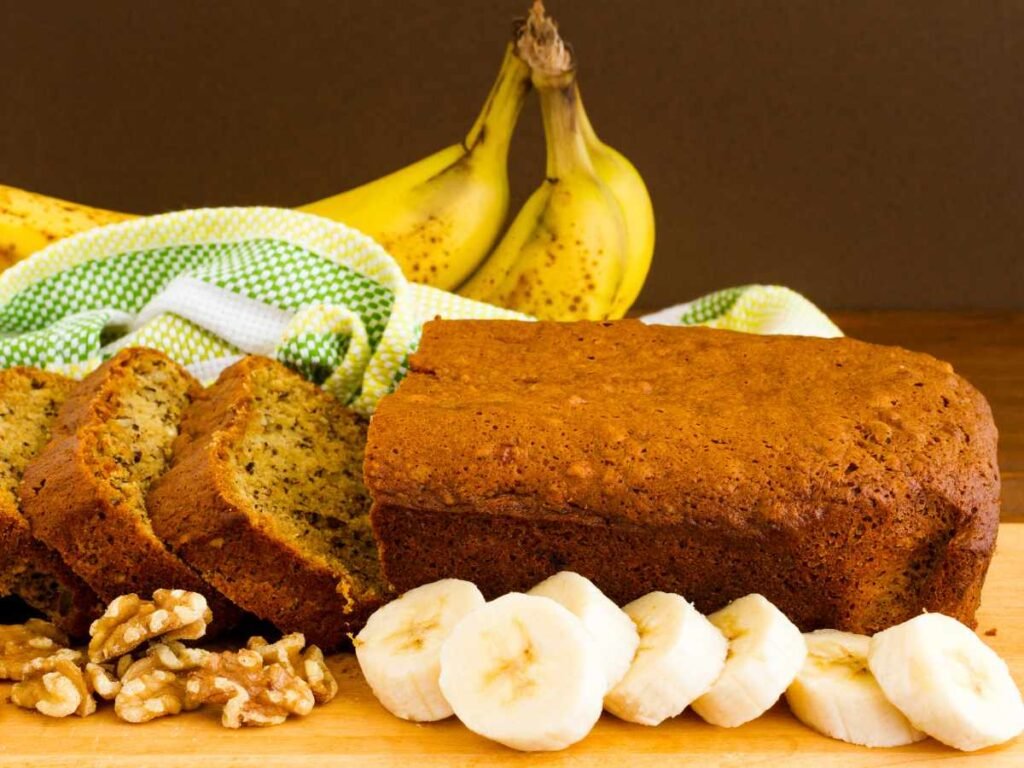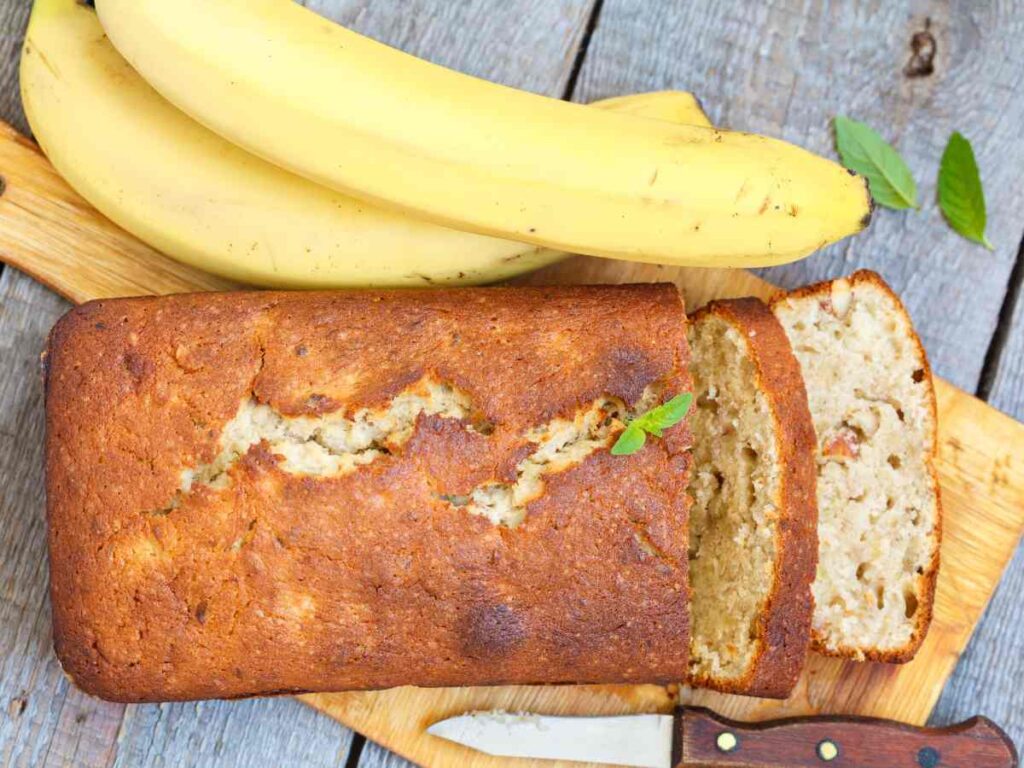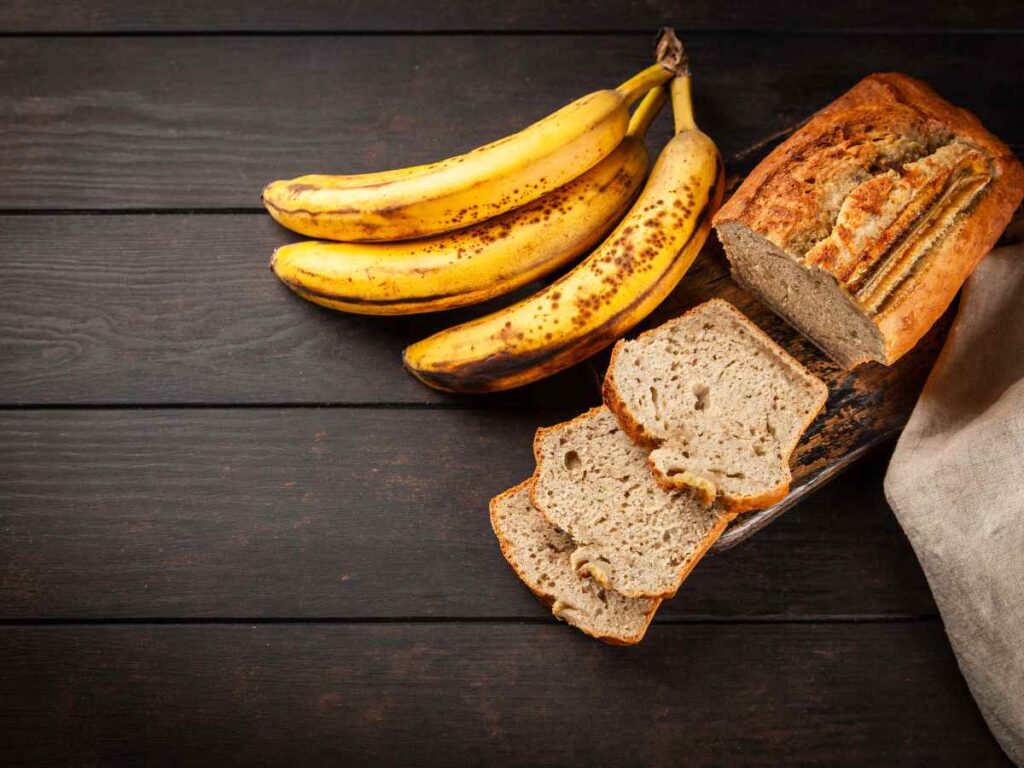The healthiness of banana bread can depend on the specific recipe and ingredients used. Traditional banana bread recipes often contain sugar, flour, and oil, which can contribute to its calorie and sugar content. However, bananas themselves are a good source of vitamins, minerals, and dietary fiber.

Create Image in Canva Pro
In This Article
To make banana bread healthier, you can consider the following tips:
- Use whole wheat flour: Replace some or all of the white flour with whole wheat flour to increase the fiber content and add more nutrients.
- Reduce sugar: Consider using less sugar or using natural sweeteners like honey, maple syrup, or mashed ripe bananas to sweeten the bread.
- Use healthy fats: Instead of using butter or vegetable oil, consider using healthier fats like olive oil, coconut oil, or applesauce.
- Add nuts and seeds: Adding nuts or seeds to your banana bread can increase its nutritional value by providing healthy fats, protein, and additional fiber.
- Incorporate other nutritious ingredients: Consider adding ingredients like oats, flaxseeds, or chia seeds to boost the nutritional content.
- Limit add-ins: Be mindful of the extras like chocolate chips or sugary toppings, as they can increase the calorie and sugar content.
It’s essential to remember that moderation is key, and enjoying treats like banana bread as part of a balanced diet is generally fine. Additionally, individual dietary needs and preferences may vary, so what is considered healthy can differ from person to person. If you have specific health concerns or dietary restrictions, it’s always a good idea to consult with a healthcare professional or a nutritionist.
What Is Banana Bread?
Banana bread is a type of sweet baked bread that is made using ripe bananas as a primary ingredient. It is a popular and classic recipe in many households. The ripe bananas contribute natural sweetness, flavor, and moisture to the bread. The basic ingredients for banana bread typically include mashed bananas, flour, sugar, butter or oil, eggs, and baking soda or baking powder.
Additional ingredients such as nuts, chocolate chips, or dried fruits may be added to enhance the flavor and texture. The batter is mixed and then baked in a loaf-shaped pan until it rises and forms a moist, delicious bread.
This bread is a great way to use overripe bananas that might otherwise be discarded. It has a dense, moist texture and a sweet banana flavor. It can be enjoyed as a breakfast treat, snack, or dessert. Many variations of banana bread exist, incorporating different ingredients and flavors to suit individual preferences. It’s a versatile and easy-to-make baked good that has become a classic comfort food for many people.
Banana Bread Nutrition
The nutritional content of banana bread can vary based on the specific recipe and ingredients used. However, I can provide a general idea of the nutritional components of a standard banana bread slice (approximately 64 grams or 1/10th of a 9×5-inch loaf). Keep in mind that these values are estimates and can vary:
| Calories | Around 196 calories |
| Protein | Approximately 2.6 grams |
| Fat | Roughly 8.3 grams |
| Saturated Fat | About 1.5 grams |
| Unsaturated Fat | About 6.6 grams |
| Carbohydrates | Around 30.8 grams |
| Dietary Fiber | About 1.6 grams |
| Sugars | Approximately 13.7 grams |
| Cholesterol | About 31 milligrams |
| Sodium | Around 198 milligrams |
These values are based on a standard banana bread recipe that includes ingredients like all-purpose flour, sugar, eggs, vegetable oil, bananas, baking soda, and salt. If you use alternative ingredients, such as whole wheat flour, natural sweeteners, or healthier fats, the nutritional profile may change.
It’s essential to note that the nutritional content can vary significantly depending on the specific recipe and the quantities of ingredients used. If you have specific dietary concerns or are following a particular nutritional plan, it’s a good idea to calculate the nutrition facts based on your recipe or consult with a registered dietitian for more personalized information.
Why Has Banana Bread Become So Popular?
As of my last knowledge update in January 2022, I don’t have real-time information on current trends or popularity. However, I can provide some general reasons why this bread has been popular in the past and could continue to be popular:

Create Image in Canva Pro
- Comfort Food Trend: This bread is often associated with comfort food. During times of stress, uncertainty, or global events, people tend to turn to familiar and comforting foods. The COVID-19 pandemic, for example, led to an increase in home baking, and banana bread became a popular choice due to its simplicity and the availability of overripe bananas.
- Ease of Preparation: This bread is relatively easy to make, requiring common ingredients that are often already available in households. The simplicity of the recipe makes it accessible for people of various skill levels in the kitchen.
- Versatility: This bread is a versatile recipe that allows for various modifications. Individuals can customize it by adding nuts, chocolate chips, or other ingredients based on personal preferences. This versatility contributes to its popularity, as people can tailor the recipe to their liking.
- Use of Overripe Bananas: This bread is an excellent way to use overripe bananas that might otherwise be discarded. The natural sweetness of ripe bananas enhances the flavor of the bread, making it a sustainable and economical choice.
- Social Media Influence: Trends in food often spread through social media platforms. If a particular recipe or food gains attention on platforms like Instagram, TikTok, or Pinterest, it can quickly become popular as people share their creations and inspire others to try it.
- Nostalgia: This bread is a classic recipe that many people have enjoyed since childhood. Nostalgia can play a significant role in the popularity of certain foods, as people seek comfort in familiar tastes and memories.
- Healthier Variations: With an increased focus on health and wellness, people may be drawn to this bread recipes that incorporate healthier ingredients, such as whole wheat flour, alternative sweeteners, or added nuts for nutritional benefits.
Keep in mind that food trends can be influenced by various factors, and popularity may vary over time. If this bread is currently trending, it could be due to a combination of these factors and the ongoing interest in home baking and comfort foods.
Is Banana Bread Better For You Than Whole Wheat Bread?
Comparing this bread to whole wheat bread involves considering various factors, such as nutritional content, ingredients, and how each fits into a balanced diet. Here’s a general comparison:
- Nutrient Content
| Banana Bread | Whole Wheat Bread |
|---|---|
| The nutrient content of this bread can vary based on the recipe. While it may contain some nutrients from bananas, it might also include added sugars and fats. However, bananas do provide potassium, vitamin C, and dietary fiber. | Whole wheat bread is typically made from whole grains, offering fiber, vitamins, and minerals. It’s a good source of complex carbohydrates, which can provide sustained energy. |
- Fiber
| Banana Bread | Whole Wheat Bread |
|---|---|
| Depending on the recipe, this bread may contain some dietary fiber, especially if whole grain flour is used. | Whole wheat bread is naturally higher in fiber compared to many banana bread recipes. Fiber is beneficial for digestive health, and it can help with satiety and weight management. |
- Added Sugars and Fats
| Banana Bread | Whole Wheat Bread |
|---|---|
| Some of these bread recipes may include added sugars and fats, which can contribute to calorie content. Choosing recipes with less added sugar and healthy fats can improve the overall nutritional profile. | While some commercial whole wheat breads may contain added sugars or fats, choosing whole wheat bread with minimal added ingredients can be a healthier option. |
- Calorie Content
| Banana Bread | Whole Wheat Bread |
|---|---|
| The calorie content of this bread can vary, but it may be higher due to added sugars and fats. | Whole wheat bread can provide a more balanced source of energy with fewer added sugars and potentially lower calorie content. |
- Overall Nutritional Profile
| Banana Bread | Whole Wheat Bread |
|---|---|
| Depending on the recipe, banana bread can offer some nutrients from bananas but may lack the diverse nutritional profile of whole wheat bread. | Whole wheat bread is generally considered a healthier option due to its whole grain content, providing a range of essential nutrients |
While banana bread can be a tasty treat with some nutritional benefits from bananas, whole wheat bread is generally considered a healthier choice for regular consumption. Whole wheat bread provides more fiber, a better balance of nutrients, and fewer added sugars and fats. However, individual recipes and variations can influence these comparisons, so it’s essential to read ingredient labels and choose options that align with your nutritional goals.
Is Banana Bread Bad for You
Whether banana bread is considered “bad” for you depends on various factors, including its ingredients, portion size, and your individual dietary needs and health goals.
This is typically made with ingredients like bananas, flour, sugar, eggs, and baking soda. While bananas provide essential nutrients such as potassium, vitamin C, and dietary fiber, other ingredients like sugar and flour contribute calories without many essential nutrients. Additionally, some recipes may include added fats, such as butter or oil.
Here are some considerations:
- Nutrient Content: Banana bread can offer some nutritional benefits from bananas, but it may lack the diverse nutrients found in whole fruits, vegetables, and whole grains.
- Caloric Content: The calorie content of banana bread can be relatively high, especially if it contains added sugars, fats, or large portions. Consuming excessive calories may contribute to weight gain if not balanced with physical activity.
- Added Sugars: Some recipes may include a significant amount of added sugars, which can contribute to health issues like obesity and dental problems. If you’re concerned about sugar intake, consider using ripe bananas for natural sweetness and reducing added sugars.
- Whole Grains: Opting for banana bread made with whole grain flour can provide additional fiber and nutrients compared to refined white flour.
- Portion Size: Moderation is key. Eating a small portion of banana bread as part of a balanced diet is different from regularly consuming large portions
- Individual Health Factors: Consider your individual health status, dietary preferences, and any specific health conditions. For example, individuals with diabetes may need to be mindful of carbohydrate content, and those with gluten sensitivity should choose gluten-free recipes.
To make banana bread healthier, you can try the following modifications:
- Use whole wheat flour or a combination of whole wheat and all-purpose flour to boost fiber.
- Reduce the amount of added sugar or use alternatives like honey, maple syrup, or mashed ripe bananas for sweetness.
- Include healthy fats by adding nuts or seeds to the recipe.
- Experiment with other nutritious ingredients, such as oats, flaxseeds, or Greek yogurt.
Banana bread can be part of a balanced diet when consumed in moderation and made with wholesome ingredients. You can also experiment with healthier variations by using whole grains, reducing added sugars, and incorporating other nutritious ingredients. If you have specific dietary concerns or health conditions, it’s always a good idea to consult with a healthcare professional or a registered dietitian for personalized advice.
What Are The Black Lines In Banana Bread?
The black lines or streaks that you might observe in this bread are likely due to the oxidation of bananas. Bananas contain polyphenol oxidase, an enzyme that reacts with oxygen in the air. When bananas are mashed or exposed to the air, this enzyme catalyzes a reaction that leads to the formation of melanin, the pigment responsible for the darkening of fruits.
Here’s why you may see black lines in banana bread:
| Mashed Bananas | Overripe Bananas |
|---|---|
| When you mash ripe bananas for banana bread, you expose a larger surface area to oxygen. This can lead to the oxidation of the bananas, causing them to turn brown or even develop black streaks. | If the bananas used in the banana bread batter are very ripe or overripe, they are more likely to have a higher concentration of enzymes that promote oxidation. |
While the appearance of black lines might not be visually appealing, it’s important to note that it doesn’t necessarily affect the taste or safety of the banana bread. Overripe bananas are often preferred in banana bread recipes because they have a sweeter flavor, and the darkening due to oxidation is a natural process.
To minimize the appearance of black lines in your banana bread:
- Choose bananas that are just ripe or slightly overripe.
- Mash the bananas just before incorporating them into the batter.
- Consider adding a small amount of acid, such as lemon juice, to the mashed bananas. The acid can slow down the oxidation process.
Remember that the presence of these lines is primarily a cosmetic issue, and the banana bread is still safe to eat as long as it has been properly baked and stored.
What Is The Healthy Recipe For Banana Bread?
Certainly! Here’s a basic recipe for classic banana bread. Feel free to customize it based on your preferences or dietary restrictions.

Crate Image in Canva Pro
Ingredients:
- 3 to 4 ripe bananas, mashed
- 1/3 cup (80ml) melted butter or vegetable oil
- 1 teaspoon vanilla extract
- 1 teaspoon baking soda
- Pinch of salt
- 3/4 cup (150g) granulated sugar
- 1 large egg, beaten
- 1 1/2 cups (190g) all-purpose flour
- Optional: 1/2 to 1 cup (60-120g) chopped nuts (walnuts or pecans) or chocolate chips
Instructions:
- Preheat the Oven: Preheat your oven to 350°F (175°C). Grease a 9×5-inch (23×13 cm) loaf pan.
- Mash the Bananas: In a mixing bowl, mash the ripe bananas using a fork or potato masher until completely smooth.
- Mix Wet Ingredients: Add the melted butter or oil, vanilla extract, and beaten egg to the mashed bananas. Mix well.
- Add Dry Ingredients: Sprinkle the baking soda and salt over the banana mixture, and then gently stir in the sugar and flour until just combined. Avoid over mixing to prevent a dense texture.
- Optional Add-Ins: If you are using nuts or chocolate chips, incorporate them into the batter at this point.
- Pour into Pan: Pour the batter into the greased loaf pan and distribute it evenly.
- Bake: Bake in a preheated oven for 60-70 minutes, or until a toothpick inserted in the center comes out clean. Baking timings can vary, so check around the 50-minute mark.
- Cool: Allow the banana bread to cool in the pan for about 10 minutes, then transfer it to a wire rack to cool completely before slicing.
- Serve: Once cooled, slice and serve. Enjoy your homemade banana bread!
Feel free to experiment with variations, such as using whole wheat flour, reducing sugar, or incorporating alternative sweeteners. This basic recipe provides a solid foundation, and you can tailor it to suit your taste and dietary preferences.
Key Conclusion
- Banana bread can be a healthy option when made with mindful ingredient choices.
- Opting for whole wheat flour, reducing sugar, using healthy fats, adding nuts or seeds, and incorporating nutritious extras can enhance its nutritional value.
- Moderation and consideration of individual dietary needs are essential for determining the overall healthiness of banana bread.
FAQs
Q1. Is Banana Bread Really Bread or Just Cake?
Banana bread shares characteristics of both bread and cake, but it is generally considered more like cake due to its sweetness, moist texture, and use of baking soda or baking powder as leavening agents.
Q2. Why Is Banana Nut Bread Considered Healthy?
Banana nut bread is considered relatively healthy due to the nutritional benefits of bananas (potassium, fiber) and the inclusion of nuts, which provide healthy fats, protein, and additional nutrients. However, its overall healthiness depends on factors like ingredient choices, portion sizes, and individual dietary goals.
Q3. What Goes Great With Banana Bread?
Banana bread pairs well with butter, cream cheese, or nut butter. It also complements spreads like honey or fruit preserves.
Q4. Is Banana Bread Bad for Weight Loss?
While banana bread can be delicious, it’s often high in calories, sugar, and refined flour, which may not align with weight loss goals. Moderation and choosing healthier variations with whole grains and less added sugar can make it a more weight-friendly option.
Q5. Is Banana Bread Good or Bad for You?
In moderation, banana bread can be part of a balanced diet.
Q6. Is Homemade Banana Bread Bad for You?
Homemade banana bread allows better control over ingredients, making it a relatively healthier option.
Q7. Is Banana Bread Good for Your Heart?
Banana bread can be a part of a heart-healthy diet when made with nutritious ingredients like whole grains and nuts. Bananas contribute potassium, which is beneficial for heart health.
Q8. Is Banana Bread Bad for Diabetics?
Traditional banana bread can be high in sugar and refined carbohydrates, making it less suitable for individuals with diabetes. However, you can make diabetes-friendly banana bread by using whole grains, reducing added sugars, and controlling portion sizes.
Q9. Is Banana Bread Bad for Cholesterol?
The impact of banana bread on cholesterol depends on its ingredients. Traditional recipes often include added sugars and saturated fats, which can potentially contribute to elevated cholesterol levels.
Q10. Is Banana Bread Bad for Kidneys?
Banana bread itself is not inherently bad for the kidneys. Bananas, a primary ingredient in banana bread, are a good source of potassium. While potassium is an essential nutrient, individuals with kidney problems may need to monitor their potassium intake, as elevated levels can be problematic for kidney function.

